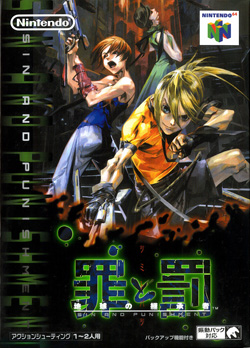Sin and Punishment
| Sin and Punishment | |
|---|---|

Japanese box art
|
|
| Developer(s) |
Nintendo R&D1 NST Treasure |
| Publisher(s) | Nintendo |
| Director(s) | Hideyuki Suganami |
| Producer(s) | Masato Maegawa Takehiro Izushi Hiroshi Yamauchi |
| Designer(s) | Hitoshi Yamagami Takahiro Harada Ryūji Kuwaki |
| Programmer(s) | Atsutomo Nakagawa |
| Artist(s) | Yasushi Suzuki |
| Composer(s) | Toshiya Yamanaka |
| Platform(s) | Nintendo 64 iQue Player |
| Release date(s) |
Nintendo 64
|
| Genre(s) | Cabal shooter |
| Mode(s) | Single-player, multiplayer |
Sin and Punishment (罪と罰 ~地球の継承者~ Tsumi to Batsu: Hoshi no Keishousha?, "Sin and Punishment: Successor of the Earth") is a shooter game developed by Treasure and Nintendo Research & Development 1, published by Nintendo. The game was released for the Nintendo 64 in Japan in 2000, and on the iQue Player in China in 2004, before being re-released internationally for Nintendo's Virtual Console service in 2007. The game's success on Virtual Console prompted Nintendo to announce a sequel for the Wii titled Sin & Punishment: Star Successor, which was released in 2009.
The game is a 3D Cabal-styled shooter with scrolling. Progress through the levels is automatic; the player's job is to aim and fire at enemies, sidestep, roll, jump, or double-jump to avoid attacks and obstacles.
The player can switch between manual (red targeting reticle) and lock-on (purple targeting reticle) firing modes at any time. Lock-on mode "sticks" the reticle to enemies, but is less damaging than manually aimed fire. The player can also attack using a powerful energy sword by tapping the fire button when enemies, or certain types of projectiles, are within close range. Projectiles struck in this manner are bounced back and can potentially inflict great damage on opponents. While the player attacks, a timer at the top of the screen counts down. When the timer hits 0, the player gradually loses more and more life until he or she either refills the timer or dies.
Multiplayer involves two players controlling one character cooperatively. The second player controls the targeting sight and shoots while the first player controls the character's movement.
...
Wikipedia
